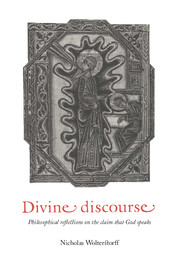Book contents
- Frontmatter
- Contents
- Preface
- 1 Locating our topic
- 2 Speaking is not revealing
- 3 The many modes of discourse
- 4 Divine discourse in the hands of theologians
- 5 What it is to speak
- 6 Could God have and acquire the rights and duties of a speaker?
- 7 Can God cause the events generative of discourse?
- 8 In defense of authorial-discourse interpretation: contra Ricoeur
- 9 In defense of authorial-discourse interpretation: contra Derrida
- 10 Performance interpretation
- 11 Interpreting the mediating human discourse: the first hermeneutic
- 12 Interpreting for the mediated divine discourse: the second hermeneutic
- 13 Has Scripture become a wax nose?
- 14 The illocutionary stance of biblical narrative
- 15 Are we entitled?
- 16 Historical and theological afterword
- Notes
- Index
3 - The many modes of discourse
Published online by Cambridge University Press: 01 June 2011
- Frontmatter
- Contents
- Preface
- 1 Locating our topic
- 2 Speaking is not revealing
- 3 The many modes of discourse
- 4 Divine discourse in the hands of theologians
- 5 What it is to speak
- 6 Could God have and acquire the rights and duties of a speaker?
- 7 Can God cause the events generative of discourse?
- 8 In defense of authorial-discourse interpretation: contra Ricoeur
- 9 In defense of authorial-discourse interpretation: contra Derrida
- 10 Performance interpretation
- 11 Interpreting the mediating human discourse: the first hermeneutic
- 12 Interpreting for the mediated divine discourse: the second hermeneutic
- 13 Has Scripture become a wax nose?
- 14 The illocutionary stance of biblical narrative
- 15 Are we entitled?
- 16 Historical and theological afterword
- Notes
- Index
Summary
When we think of someone promising, asking, or asserting something, the image which comes most naturally to mind is that of someone using her mouth and tongue and vocal cords to make the sounds of some language, or using her hands to inscribe the characters of some language. So much are we in the grip of this as the paradigm for discourse that, as noted in our first chapter, a good many theologians, upon hearing talk of God speaking, have concluded immediately that this is metaphor if not nonsense, on the ground that God has neither mouth nor tongue, vocal cords nor hands. Whether the attribution of speech to God is in fact either metaphor or nonsense is a topic I will address in a subsequent chapter. As preliminary for that, I propose to reflect here on the many modes of discourse. There are many ways of saying things other than by making sounds with one's vocal apparatus or inscribing marks with one's limbs.
A terminological point is worth emphasizing: by “saying” and “speaking” and “discoursing,” I will never have in mind what Austin called locutionary actions, that is, actions of uttering or inscribing words, but only such actions as can be what he called illocutionary actions – commanding, promising, asserting, and so on. I say: “such actions as can be illocutionary actions.”
- Type
- Chapter
- Information
- Divine DiscoursePhilosophical Reflections on the Claim that God Speaks, pp. 37 - 57Publisher: Cambridge University PressPrint publication year: 1995



